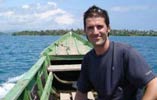About
The focus of research in the Environmental Dynamics Lab (ENDLab) is on using meticulously planned and executed field and laboratory experiments to obtain insight into all manner of dynamical phenomena, from micro-scale diffusive processes to regional ocean transport to global-scale oceanic wave fields. To complement this work we pursue theoretical and numerical modeling, either in-house or through collaborations. We regularly lead or participate in a wide range of field studies, with members of our lab recently or soon to be heading off to Hawaii, the South China Sea, the Indian Ocean, the Arctic Ocean and the South West Pacific..

"In anything at all, perfection is finally attained not when there is no longer anything to add, but when there is no longer anything to take away."
—

© 2009 Thomas Peacock
One of our general areas of research can be classed as stratified flows (i.e. fluid flows influenced by the combination of gravity and a density stratification), which lies at the heart of many industrial applications and environmental phenomena. In some cases, we perform very fundamental laboratory studies; examples being the discovery of a new form of propulsion in stratified fluids (which we call "sailing on diffusion"), instabilities, and the settling of particles in stratified fluids. The major focus of our stratified flow research is oceanic internal waves, which are propagating disturbances of the density stratification in the ocean, generated by flow over sea-floor topography and sea-surface winds. Their dissipation enhances ocean mixing, which influences the Earth's climate; and from an engineering perspective, internal waves impact the performance of ocean technology such as exploration vessels and pipelines.
Our other main research area pursues the latest ideas in nonlinear dynamics. A particularly vibrant research area is the development and application of methods that reveal Lagrangian coherent structures in fluid flows. These are structures that aren't necessarily apparent to the naked eye, but play a key role in organizing fluid transport. Through a combination of experiment and theory, we have developed methods to uncover the Lagrangian skeleton of turbulence, tracked flow separation in unsteady flows, and revealed the whereabouts of internal wave attractors. In the coming years, we are developing these methods for application to ocean decision-making scenarios (e.g. oil spills, search-and-rescue) as well as to understanding flow transport in-and-around coral reef systems and the design of marine protected areas (MPAs).
A new major initiative that we are pursuing is the study of sediment laden plumes in stratified environments with application to deep-sea mining activities. We are developing analytical and numerical models, and planning laboratory and field experiments in order to provide a clear understanding of how these activities may impact the ocean environment.
Thanks for visiting the ENDLab website. If you need any more information, please contact us. We'll be happy to provide you with more information.



